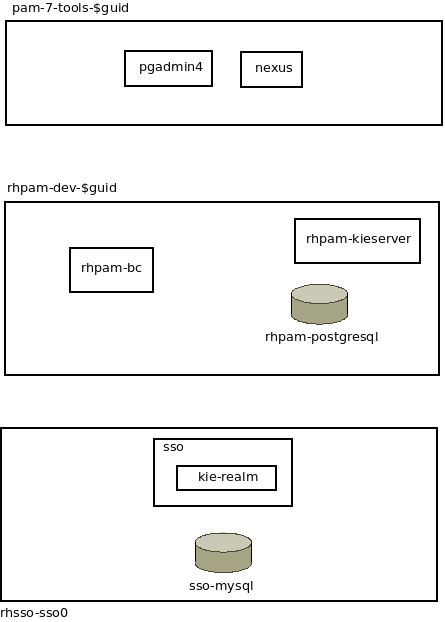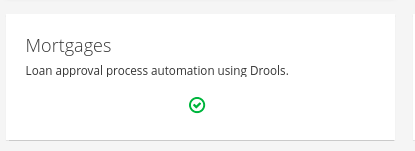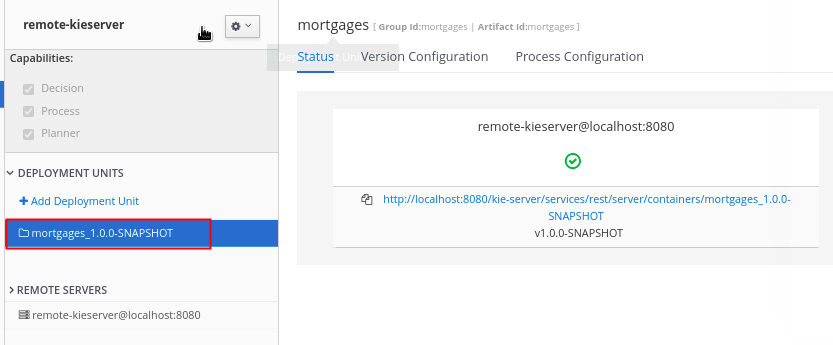RHPAM Provisioning
-
Existing OCP 4.X cluster environment
-
Authentication to that existing OCP 4.X environment as a cluster admin user.
1. Overview
This ansible assists in the provisioning of one or more Red Hat Process Automation Manager instances on a pre-existing OpenShift environment.
This ansible is useful for supporting demos and labs where the focus is the RH-PAM product.
The RH-PAM KIE-Server is configured to leverage a PostgreSQL database.
The following diagram depicts the OpenShift project and corresponding components provisioned by the ansible (along with related ansible):
-
pam7-tools-{{ ocp_user }}
This OCP project contains a Nexus server and a pgadmin4 server.
-
rhpam-dev-{{ ocp_user }}
This OCP project contains the PAM Business Central and PAM Kie-server. The PAM Kie-server stores the state of long running business processes in the rhpam-postgresql database.
-
rhsso-sso0
RH-PAM offers the ability to optionally secure Business Central and Kie-server using the OpenID Connect protocol. This rhpam-dev-ansible project provides the ability to optionally integrate with a RH-SSO environment.
A RH-SSO environment can be provisioned using the rh-sso-multi-realm ansible. The rh-sso-multi-realm ansible will create an OCP project called rhsso-sso0 . Within this rhsso-sso0 OCP project, a RH-SSO and corresponding mysql databased will be installed.
The RH-SSO instance will be pre-configured with a SSO realm called: kieRealm. kieRealm comes pre-configured with users and roles that support RH-PAM Business Central and Kie-Server.
2. Optional Integration with RH-SSO
As per the Deploying a RH-PAM Authoring Env on RHT OCP, Business Central and KIE-Server can be secured via the OpenID Connect protocol by integrating with RH-SSO.
This ansible optionally allows for the provisioning of Business Central and KIE-Server integrated with a previously configured RH-SSO.
The out-of-the-box defaults for integration with RH-SSO closely allign with an RH-SSO provisioned via rh-sso-multi-realm ansible.
All of the default ansible variables needed for integrating with RH-SSO can be found in the following file of this project: roles/openshift_rhpam_dev/defaults/main.yml . The default values of these variables can all be over-written at the ansible-playbook command line.
2.1. Auto-Generated SSO Clients
Upon start-up of the Business Central and KIE-Server web apps, the following corresponding SSO clients will be created (by each of those web apps) in the kieRealm of RH-SSO:
-
business-central
-
kie-server
Both SSO clients are configured with an Access Type of: confidential
2.2. Smoke Test KIE-Server integrated with RH-SSO
In this section, you will retrieve an OAuth2 token from the kieRealm SSO realm and use that token to invoke the RESTful API of the KIE-Server. For the purpose of demonstration, Linux/OSX command line tools will be used.
2.2.1. Deploy the Mortgages Application
In this quick start, you will use the Mortgages Trial Sample based on Drools
-
Import the project via Business Central.
-
Study the rules and data objects.
-
Build and deploy to your KIE-Server.
-
Set an environment variable whose value is the name of the newly deployed
deployment unit: -
Set the environment variable:
containerId=mortgages_1.0.0-SNAPSHOT
2.2.2. Identify SSO Client Secret
The kie-server SSO client of the kieRealm allows for obtaining an OAuth2 token via the Resource Owner Password Credentials flow of OAuth2.
Because the kie-server sso client is configured as confidential, the SSO client_secret will be needed to retrieve the OAUth2 token.
2.2.3. Invoke Mortage app via SSO Secured KIE-Server
Now that the Mortgage app has been deployed to your RH-PAM KIE-SERVER and you know the client_secret of your SSO kie-realm, you can obtain an OAuth2 access token from RH-SSO and use that token to invoke the rules of the Mortgage app via the RESTful API of the KIE-server.
-
Set the following environment variables with values similar to the following:
rhsso_hostname=keycloak-rh-sso.apps.g.p.com kieserver_hostname=rhpam-kieserver-rhpam-dev-oncore.apps.g.p.com retrieve_token_url="https://$rhsso_hostname/auth/realms/kieRealm/protocol/openid-connect/token"
-
Create a request payload that will be used when firing rules of the
Mortgagesample application:echo ' { "commands": [ { "insert": { "object": { "mortgages.mortgages.Applicant": { "name": "sarah", "age": 25, "creditRating": 650 } }, "out-identifier": "applicant_sarah", "return-object": true }}, { "insert": { "object": { "mortgages.mortgages.LoanApplication": { "amount": 2500 } }, "out-identifier": "loanapp", "return-object": true }}, { "insert": { "object": { "mortgages.mortgages.IncomeSource": { "amount": "50" } }, "out-identifier": "incomesource", "return-object": true }}, { "insert": { "object": { "mortgages.mortgages.Bankruptcy": { "yearOfOccurence": "1991", "amountOwed": "11000" } }, "out-identifier": "bankruptcy", "return-object": true }}, { "fire-all-rules": { "max": 10, "out-identifier": "firedActivations" } } ] } ' > /tmp/mortgage_rules_execution.jsonNotice the existence of a bankruptcy fact in the payload. Based on the rules of the Mortgage application, you can expect that a loan application will subsequently fail.
-
Retrieve an OAuth2 token using the
kie-serverSSO client ofkieRealm:TKN=$(curl -X POST "$retrieve_token_url" \ -H "Content-Type: application/x-www-form-urlencoded" \ -d "username=pamAdmin" \ -d "password=admin1!" \ -d "grant_type=password" \ -d "client_id=kie-server" \ -d "client_secret=$client_secret" \ | sed 's/.*access_token":"//g' | sed 's/".*//g') echo $TKN eyJhbGciOiJSUzI1NiIsInR5cCIgOiAiSldUIiwia2lkIiA6ICJOd010SUpfRnFuY3BMODJSQWRJMkMxSklLcXJWUzlBRWVNSHM0RktRZi1BIn0.eyJleHAiOjE2MTA3NjEzMzUsImlhdCI6MTYxMDc2MTAzNSwianRpIjoiOGM1YzJlZTAtMmZmZi00MGFhLTg0MGYtZWE2N2MxYWViNWZjIiwiaXNzIjoiaHR0cHM6Ly9rZXljbG9hay1yaC1zc28uYXBwcy5yaHRuY2twbWcucmhzbGVkb2NwLmNvbS9hdXRoL3JlYWxtcy9raWVSZWFsbSIsImF1ZCI6ImFjY291bnQiLCJzdWIiOiIzMmE4NjczNi04MThiLTRiM2MtODQyZi0zY2U4OGU3MjJkZGMiLCJ0eXAiOiJCZWFyZXIiLCJhenAiOiJraWUtc2VydmVyIiwic2Vzc2lvbl9zdGF0ZSI6Ijk0M2Y3NzRhLTgyOTItNDg1Mi04MmZkLWY2ZGNiMGU0NzQ0YiIsImFjciI6IjEiLCJhbGxvd2VkLW9yaWdpbnMiOlsiaHR0cHM6Ly9yaHBhbS1raWVzZXJ2ZXItcmhwYW0tZGV2LW9uY29yZS5hcHBzLnJodG5ja3BtZy5yaHNsZWRvY3AuY29tOjQ0MyIsImh0dHBzOi8vcmhwYW0ta2llc2VydmVyLXJocGFtLWRldi1vbmNvcmUuYXBwcy5yaHRuY2twbWcucmhzbGVkb2NwLmNvbSJdLCJyZWFsbV9hY2Nlc3MiOnsicm9sZXMiOlsia2llbWdtdCIsImFkbWluIiwicmVzdC1hbGwiLCJBZG1pbmlzdHJhdG9ycyIsImtpZS1zZXJ2ZXIiLCJ1c2VyIl19LCJyZXNvdXJjZV9hY2Nlc3MiOnsiYWNjb3VudCI6eyJyb2xlcyI6WyJtYW5hZ2UtYWNjb3VudCIsIm1hbmFnZS1hY2NvdW50LWxpbmtzIiwidmlldy1wcm9maWxlIl19fSwic2NvcGUiOiJwcm9maWxlIGVtYWlsIiwiZW1haWxfdmVyaWZpZWQiOmZhbHNlLCJwcmVmZXJyZWRfdXNlcm5hbWUiOiJwYW1hZG1pbiIsImVtYWlsIjoicGFtYWRtaW5Ab3BlbnNoaWZ0Lm9wZW50bGMuY29tIn0.bmHT1R25G13c4CdYK2am-5-a-Y1QwRequsXg2C55fj7kdfBr8yJ7_qRrGQxQ4spy28f3O0vdtMc10O3h3HFTPZoCaGVqfciE4axcZI2zZLdVmc6qlmfLIj-hjZMqoOB-tAYyHcFoUN9mtQmJWhCaFO0JysCUpQHeOjssSizjjRHLW5Dsg5JHqZxR4iBuG-KBlfK-cI0ryeNQV5ljdP6nNn7UrEbhHP_rFyZlmHXgOAraL6MC75Rnra0nwIvg4Wu30WXppxT7HUlQj1lFBaZQUzmFXXJBXHBq_5ofNHgervMFtmyzlG_3r892e4JS1qZ7o4fDaXyMvD1RTa6WwKpC8g -
Using the OAuth2 token, invoke the kie-server to determine its current status:
curl -v \ -H "Authorization: Bearer $TKN" \ -X GET \ https://$kieserver_hostname/services/rest/server -
Using the OAuth2 token, invoke kie-server with payload to insert facts and fire all rules of the Mortgage application:
curl -v \ -H "Authorization: Bearer $TKN" \ -H "accept: application/json" \ -H "content-type: application/json" \ -X POST http://$kieserver_hostname/services/rest/server/containers/instances/$containerId \ -d @/tmp/mortgage_rules_execution.json -
The response should include a JSON element that indicates that the loan application has been declined due to a prior bankruptcy:
{ "type" : "SUCCESS", "msg" : "Container mortgages_1.0.0 successfully called.", "result" : { "execution-results" : { "results" : [ { "value" : {"mortgages.mortgages.LoanApplication":{ "amount" : 2500, "approved" : false, "approvedRate" : null, "deposit" : null, "explanation" : "has been bankrupt", "insuranceCost" : null, "lengthYears" : null }}
3. Environment Variables
-
businesscentral_image_namespace
Optional. Default = rhpam-dev-{{ ocp_user }} Name of project where Business Central image stream resides.
-
configure_smtp_relay
Optional. Default = false
When set to true, kie-server pod is injected with a sidecar that listens on port 25. All outbound SMTP traffic will be relayed to a remote SMTP server. This SMTP relay leverages the following additional variables:
-
smtp_host
-
smtp_port
-
smtp_userid
-
smtp_passwd
-
-
fake_smtp
Optional. Default = false
FakeSMTP is a Fake SMTP Server with GUI for testing emails in applications easily. It is written in Java.
When this variable is set to true, kie-server pod is injected with a fake SMTP server sidecar.
-
install_tools
Optional. Default=true
When set to false, the pam-7-tools-$userId namespace is not created and corresponding Nexus and PostgreSQL Admin Console are not provisioned.
-
kieserver_image_namespace
Optional. Default = rhpam-dev-{{ ocp_user }} Name of project where KIE Server image stream resides.
-
kieserver_java_opts_append
Optional. Default = -Dorg.kie.mail.session=java:jboss/mail/Default
Used to add system properties to KIE-server
-
OCP_WILDCARD_DOMAIN
Required when provisioning RH-PAM KIE-Server
Examples: apps.ratwater.xyz
-
provision_businesscentral
Optional; Default is true
When set to false, Business Central will not be provisioned
-
provision_kieserver
Optional; Default is true
When is to false, neither KIE Server nor its corresponding postgresql database will not be provisioned
-
provision_monitoring
Optional; Default is false
If set to true, a PAM Business Central Monitoring pod will be provisioned.
-
rhsso_url
Optional;
If set, value should be of convention: https://sso-rhsso-sso0.apps-71b4.generic.opentlc.com/auth
If set, BC and KIE-Server will be configured to participate in OpenID Connect (OIDC) security
-
seq_start
Optional. Set this variable when needing to provision a lab environment for multiple students on an existing OCP environment. Specify first rhpam env to manage; default = 1 ; in which a project with the following name will be created: rhpam-dev-user1.
-
seq_end
Optional. Specify last rhpam env to manage; default = 1
-
use_cluster_quota
Optional. Default value is: true
When true, creates a clusterquota that is assigned to the owner userId (ie: user1) of the project where the RH-PAM deployment resides. The values of this clusterquota are found in: roles/openshift_quota/defaults/main.yml
-
use_custom_pam
Optional;
Default value is false in which case PAM images from registry.redhat.io will be used.
If set to true, then custom images for Business-Central and KIE Server will be used. The images are configured with users and groups required to support GPTE courses and labs.
-
use_ephemeral_postgresql
Default value is false in which case PostgreSQL (for KIE-Server) uses a persistent volume claim.
4. Install Examples
4.1. All Components
ansible-playbook playbooks/install.yml \ -e fake_smtp=true \ -e configure_smtp_relay=false \ -e use_custom_pam=true \ -e kieserver_image=rhpam-ks-apd \ -e kieserver_image_tag=7.8 \ -e businesscentral_image=rhpam-bc-apd \ -e businesscentral_image_tag=7.8 \ -e use_ephemeral_postgresql=false \ -e rhsso_url=https://$rhsso_hostname/auth \ -e OCP_WILDCARD_DOMAIN=$OCP_WILDCARD_DOMAIN \ -e install_tools=true \ -e seq_start=1 -e seq_end=1
4.2. Individual Components
-
Provision PostgreSQL Admin Console
$ ansible-playbook playbooks/pgadmin4.yml \ -e ocp_user=$ocp_user \ -e use_cluster_quota=$use_cluster_quota -
Provision Nexus
$ ansible-playbook playbooks/nexus2.yml \ -e ocp_user=$ocp_user \ -e use_cluster_quota=$use_cluster_quota -
Provision Business Central (using custom GPTE images) only with no ClusterQuota
$ ansible-playbook playbooks/rhpam_dev.yml \ -e ocp_user=user1 \ -e use_cluster_quota=false \ -e use_custom_pam=true \ -e provision_businesscentral=true \ -e provision_kieserver=false
5. Custom PAM images generation
-
Login to Red Hat registry
podman login registry.redhat.io
-
Build images
git clone https://github.com/gpe-mw-training/advanced-process-development-labs-etc.git cd advanced-process-development-labs-etc mvn clean install cd etc/kie-server-docker podman build -t rhpam-ks-apd:1.4 .
-
Push images
podman login quay.io podman tag rhpam-ks-apd:1.2 quay.io/rhtgptetraining/rhpam-ks-apd:1.4 podman push quay.io/rhtgptetraining/rhpam-ks-apd:1.4
6. Uninstall
$ ansible-playbook playbooks/install.yml \
-e ACTION=uninstall \
-e seq_start=$seq_start \
-e seq_end=$seq_end



